A sleepless night in a house of horrors
There's an important difference between a scuttle and slither.
It was just before two in the morning when I woke up to Dave’s head-torch shining in my face. We were up Brownsberg mountain, staying in a house of horrors with a group of Dutch high school boys and their teacher for company down the corridor – plus approximately one squillion mosquitoes brewing nicely in an open-topped water storage unit directly outside our open window.
“Did you hear that?” Dave whispered. “There’s something in our room…” Considering there was no way of locking our bedroom door in this semi-abandoned, creepy excuse for a hostel, maybe I should have felt more panicked. Mostly, I was just annoyed to have been woken up like this. But then I heard it too: a distinct scurrying – or was it jumping? Or, god forbid, slithering?! – too quickly from one corner of the room to another for us to catch in the torchlight.
We cycled through turning the light out, waiting in silence, hearing the noises again and turning the torch back on – for several long minutes in that specific pattern of madness that comes with checking for monsters in the middle of the night. “What should we do?” I whispered. No reply; having successfully transferred the duty of worry onto me, Dave was fast asleep.
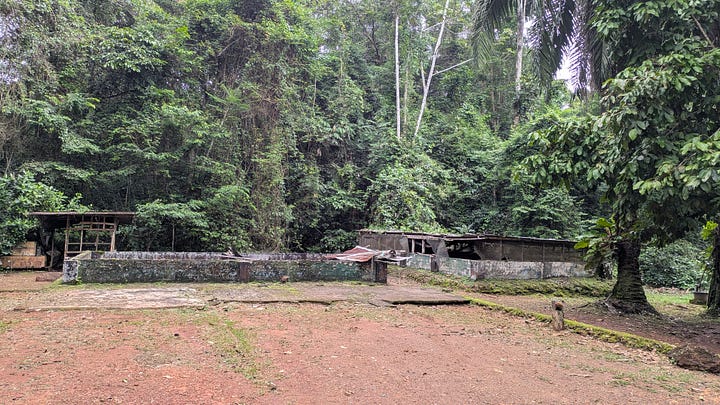
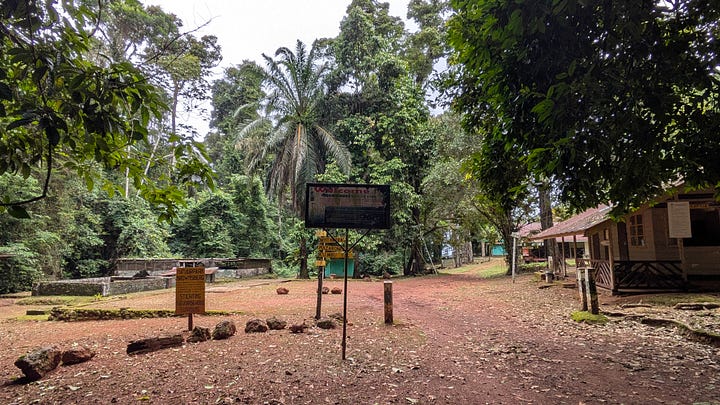
I lay awake for hours, obviously, with the vague notion that, if it was a snake, I should be conscious enough to notice if it tried to join us in the bed. For context, upon arrival up the top of Brownsberg – a mountain within Suriname’s national park of the same name – we’d learned that the local guide assigned to the visiting Dutch school group had been bitten by a coral snake (which can be deadly) and spent a day in hospital as a result. It wasn't unlikely that the same snake or one of its mates had found its way in through the many holes, cracks and craters in the floor, walls and roof of this building. I got up and dug around in our various piles of belongings, finding no creatures, but opting to pull out our remaining snacks and chuck them outside in the corridor as a lure. We survived the night.
In the morning, we studied the bite marks in the wrappers of some discarded chocolate biscuits and deduced it had probably just been a mouse. Even so, I was ready to leave the mountain.
Two days previous we’d hiked the 13km up Brownsberg in pouring rain. The dirt track used by four-by-fours and other off-roaders to cart day visitors and the occasional biologist up to the summit had turned first into rivers and then reasonably-sized lakes. The following day, we enjoyed clearer skies and broad sunshine for another challenging hike out to see some waterfalls, before returning to the accommodation site – me begrudgingly agreeing to sleep another night in a building that smelled and looked a lot like a decaying scout hall. It had been an adventure. And now I was ready to sleep in a bed with a fitted sheet on it and shower in a cubicle I wasn’t terrified of accidentally touching the sides or floor of.
Look, I’m no princess – we’ve stayed in plenty of very basic places on this trip, and I’ve removed plenty of spiders, mice, birds, even fruit bats from rooms in my time. I would like it on the record that I coped admirably well with finding worms in my bed in South Africa a couple of years ago. But when places are so thick with dirt – specifically from humans – and clearly neglected by the cleaning spray for so long, I’m squeamish. A cramped, mouldy bathroom is my idea of absolute hell. A whole building of dirt and mould piled high in spaces shared with teenage boys for two whole days? I was done.
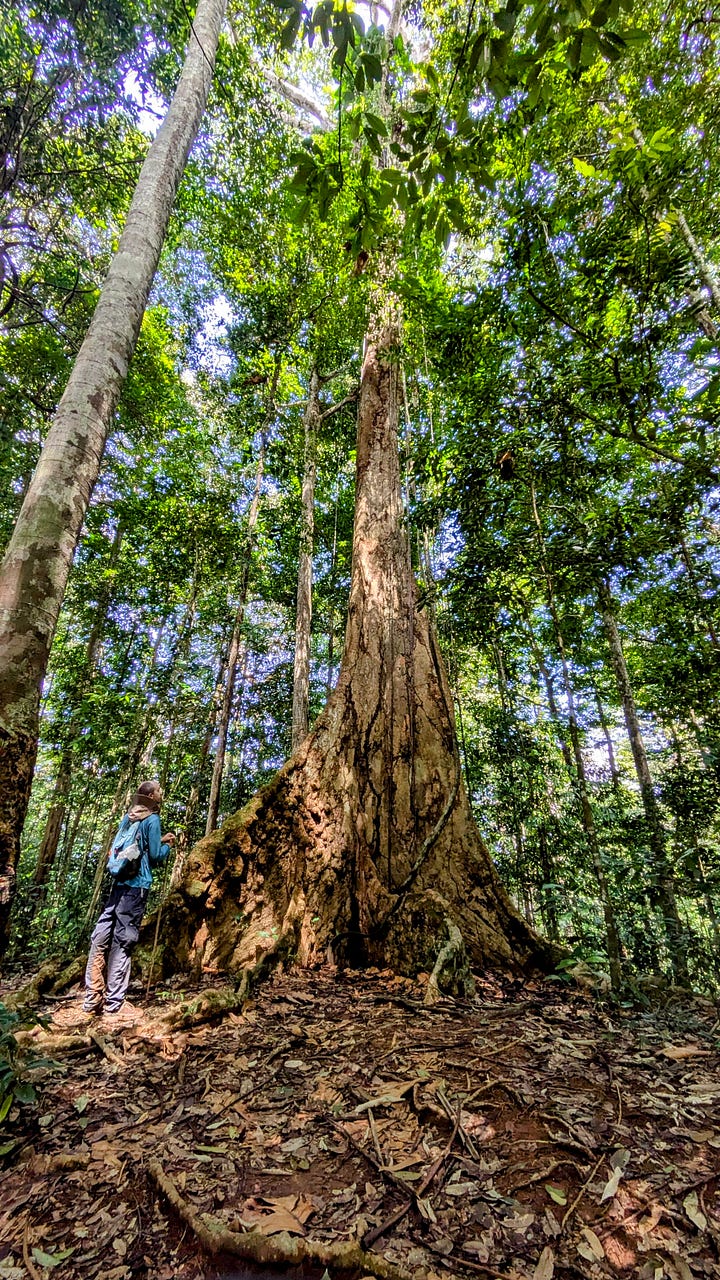

Dave and I packed up our still damp belongings and began the trek back down the mountain – and this time a couple of vans transporting Dutch day-trippers did pass us, but we opted out of flagging a lift because we were thoroughly enjoying the walk. Even during our hike up to Brownsberg through the mist and rain the scenery had been stunning. We listened to howler monkeys and spotted a huge, complete and fresh paw print in the mud that could only have been that of a jaguar… another tantalisingly close encounter.
Within the perimeters of the nature reserve, the whole landscape feels very unspoilt. Towards the bottom of Brownsberg mountain it’s a different story, because a lot of the land nearby has been carved up for mining. Gold mining, especially, has represented a significant slice of Suriname’s economy in recent years, but it’s hugely controversial. The processes used by some mining companies involve dangerous chemicals and substances like mercury, which go on to contaminate the surrounding earth and sometimes local water supplies.
The Surinamese government has also been criticised for selling off indigenous land to Chinese companies including Zijin Mining, which now owns 95 per cent of Rosebel Gold Mine, one of the largest mines in South America. It’s very sad, especially since – as one a wise taxi driver told us – the majority of Surinamese people won’t benefit from the wealth being generated.
Maybe for that reason, I was really backing the hobbyist gold panners we saw sneaking in and out of the trees on the fringes of the larger mining sites. We passed several local guys on motorbikes carrying pans and shovels, out to try their luck with some guerilla gold mining, and apparently with good reason. “Everyone does it,” a taxi driver told us later that day. “My brothers, my friends, my cousins… in the evening after work or on a Sunday, we’ll all go down for a bit of the dig.” And everyone knows someone who has struck gold, literally. But only the smartest ones will get a good price for what they find – everything is sold on the black market, since “independent” mining is illegal.


We hitched a ride back into Paramaribo with a couple of sketchy guys heading into the city for Friday night with their bags of beer and watermelons. The car stopped at regular intervals for the driver to either hand over or take wads of cash, or for the front passenger to get out and honk on something grassy from a plastic bottle with his head upside down. In any other country I might have wondered if the two of them were planning to rob and kill us, such was their nervous energy, but this was Suriname – the people seem much too open and pure to plot tourist kidnaps. And it might also have just been the drugs.
Safely back at the Opticians, Dave and I watched as litres of mud streamed out of our boots, socks and bags under the shower – and then off ourselves, too. We engaged in some light tourism – a visit to Fort Zeelandia, a fortress in Paramaribo that changed hands between the French, British, and later the Dutch in 1667 – ate some more burgers, and made a plan for the coming days. For sure, there is a lot more to see in Suriname’s interior, but we’d spent a fair bit of time and energy already trying to navigate our way up Brownsberg and the surrounding area, so we decided to call it quits and head west towards the Guyana border.
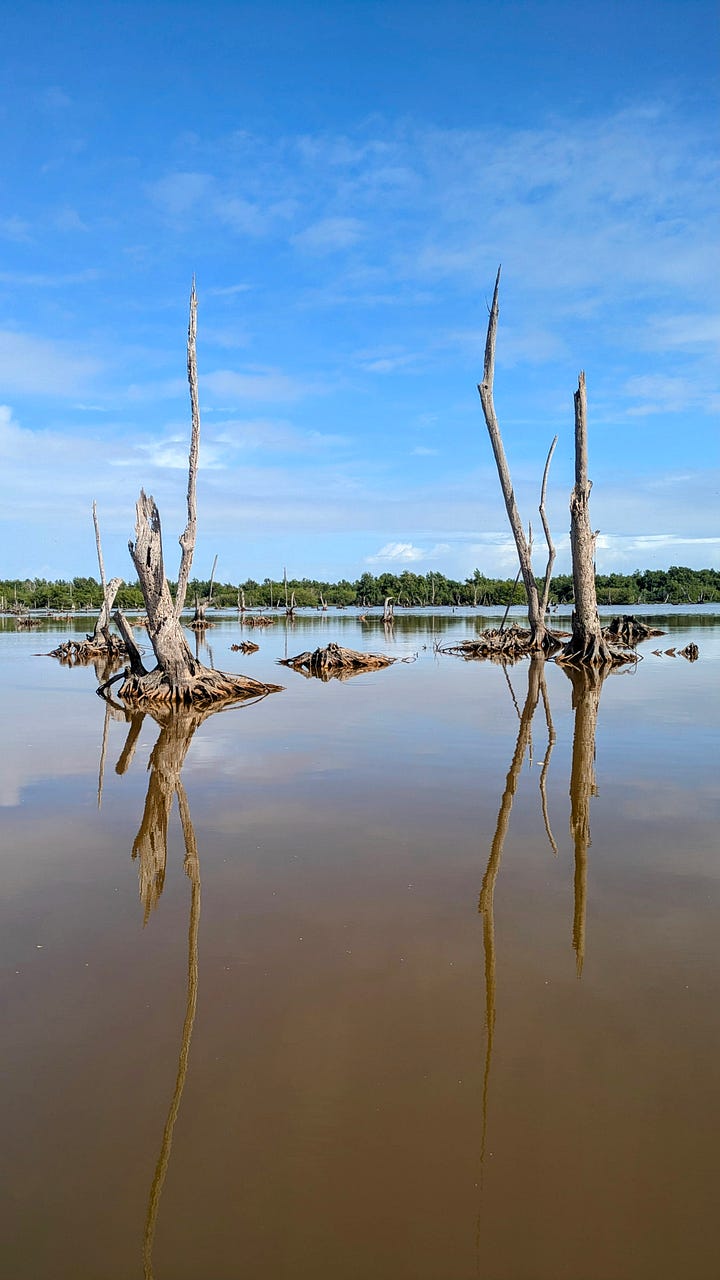
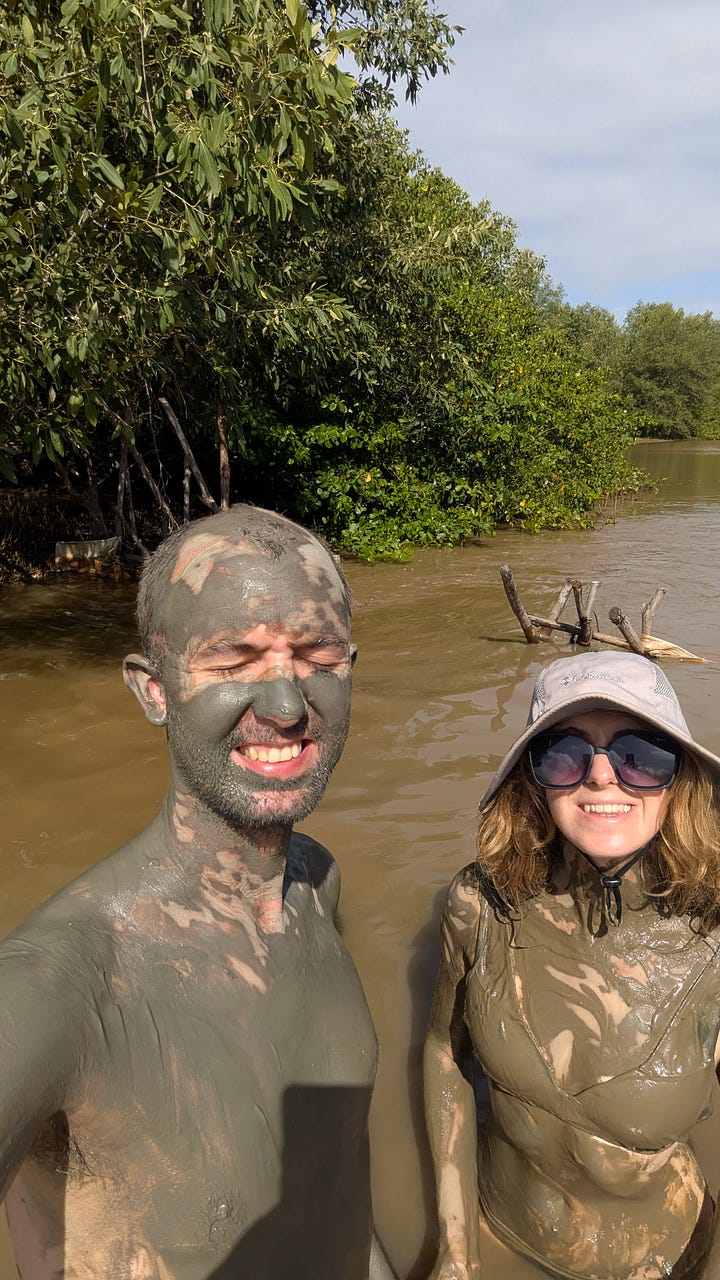
First, we stopped by Bigi Pan, a large lagoon by the coast of Suriname that’s connected to the Nickerie river. Bigi Pan is home to plenty of wildlife, including caiman, snakes and other reptiles, fish, capybara (somewhere) and more than 120 species of birds – so it’s a big deal for serious birders, who come to see rare and brightly coloured migratory ones like the scarlet ibis (which we were lucky enough to spot, but not photograph).
While I wouldn’t describe us as serious birders quite yet, part of the appeal in going to Bigi Pan was the chance to stay at Stephanie’s Lodge, one of a handful of wooden guesthouses out in the middle of the lake, built to look like they are floating (they’re not; the lake is misleadingly shallow, but you are completely surrounded by water). We briefly met a group of videographers there from Cornell University Ornithology Lab who had come to Bigi Pan specially to seek out one particular bird on film. Dave and I were very excited by this, because Cornell is where the popular bird call identifier app, Merlin, was developed (check it out if you don’t already have it!). It didn’t sound like the group had much luck in Bigi Pan, so they were loading their boat to move on to a new location. But it was cool to hear about their work – and what an amazing job, travelling the world to film wildlife in remote and beautiful places like this.

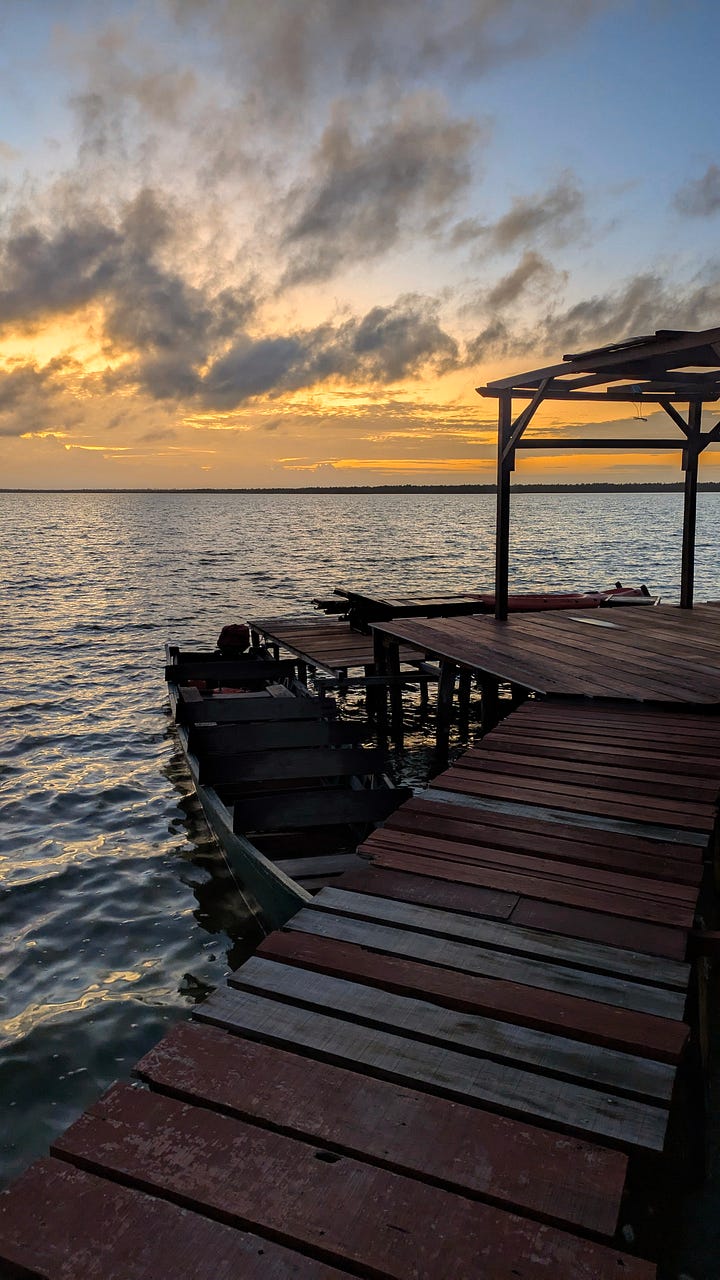
The accommodation was basic, but pleasingly so; I felt very much at peace sitting out on our little wooden deck listening to the sounds of nature without the distraction of wifi. At dusk we were taken out on a little boat across the lake by Randy, our guide at the lodge, to see thousands of egrets coming in to roost on their favourite tree – and then out again at dawn to see them waking up and taking off.
All very wholesome and calming, though Randy counterbalanced this zen during our post-dinner night drives by grabbing unsuspecting reptiles from the water to show them to us close up. I held a friendly iguana; Dave befriended a tiny tree snake until it went to bite him (which sounds terrifying until I tell you that the snake had no teeth); nobody volunteered to help hold down the rather large caiman Randy kept throwing himself into the water to wrestle with. I wondered if this was normal practice in Bigi Pan, until we ran into two more tour boats from other lodges on our second night. Their guides, very much sitting inside the boats, pointed out a caiman and also a huge boa constrictor in the trees nearby – Randy needed no invitation to jump back in the water, doing his usual caiman bothering tricks, and then suddenly he was back on the boat with the snake around his neck to show us. I felt a bit sorry for the reptiles who were just trying to go about their evening, but proud to be in with the cool guide’s gang at the same time.
To cross the border to Guyana required another boat – a much bigger and more official one this time – which meant getting to the port early doors on our day of departure. The plan was to leave before dawn: Randy would take by boat from the lagoon and out to the “mainland”, where we’d pick up the 7am bus. But at 5:50, we were presented with an unexpectedly elaborate breakfast, and I found myself forcing down four fried eggs to spare Dave’s shame, alongside a plate of fried bananas and cheese sandwiches. I blame our overzealous hosts for the fact we consequently missed the bus to the port, but Stephanie, of Stephanie’s Lodge fame, very kindly drove us there herself as part of a very big detour on the morning school run.
By 7:30am, there were already queues of people waiting outside the port to buy tickets for the ferry – most of them had come from the bus that we’d just missed. I was standing in line when a man walked over to introduce himself – he was the driver of that bus, and he’d clearly had an earful from Stephanie for not waiting for us. To make amends, he asked if we wanted to reserve a seat with him on the other side for Georgetown – he’d wait for us once we’d all disembarked the ferry, he said.
Unlike our casual little canoe rides across the river from Brazil to French Guiana, and then French Guiana to Suriname, crossing to Guyana was a rigorous affair, not to mention terrible value – $20USD for standing room only on a car ferry not designed for nearly so many foot passengers. Once the doors to the ticket office opened, a bit of a bun fight broke out among regulars wanting to get on the first ferry: a second one was rumoured to pick up the stragglers later in the morning, but at the cost of several hours’ delay.
The exit process was hilarious. After changing our remaining Surinamese money into Guyanan dollars, we were told that tickets could be purchased with Surinamese or US dollars only – which meant another dodgy exchange at a terrible rate. Then our passports were taken from us and added to a large pile in the back office; we were told to stand in a crowded room of other chosen ticket holders and wait.
At some point during my hair-pulling at the various dodgy cash exchanges, a large red American man came over to talk at me about God, the Kaieteur Waterfalls, and, separately, Trump. I’d noticed his group in the queue as the only other gringos in the vicinity, of course I had – but they stuck out even more than usual, like only a travelling church group can when spotted out in the wild. We had a polite conversation because I didn’t have the energy tell him all the ways I disagreed with him (and honestly, what would be the point). But I made my excuses when he started off on one about how the world was a “much safer place” now with Sleepy Joe gone (“all that money gone to corruption… Praise God now Trump’ll keep us safe from Mexico AND from Russia!”) – at any rate, it was time to enter the pre-immigration pen and wait for those ticket officers to finish duplicating my passport.
A wave of excitement broke out after an hour, when a small man appeared in the middle of our crowd holding several piles of passports. This, apparently, was the system: we would all wait patiently for him to go through 250 passports, one by one, in no particular order, reading out the name in each document to call forward its rightful owner – or at least giving each name his best shot, anyway. It was clear this man took his role very seriously, and he would not be hurried. Now I understood the pain of those people having to wait for that later second ferry.


Passport man had a cracking sense of humour, to be fair to him, taking his time to go through each document and telling the crowd a little fact about the holder, or giving borderline compliments for her (always her) photo inside. I didn’t have much patience for it until the name of the big American man I’d been speaking to was read out: “Now I am sending you out of my country like Trump, hahaha…” – the crowd went wild. “Oh now, really, this is just not the place for that,” one of the church wives tutted.
We, or rather our aliases “Pells Alice” and “David Great Britain”, were among the very first people off the ferry in Guyana and yet somehow we were the very last two people allowed to leave the queue through immigration on the other side. We’d been told before this trip that we’d have no problem catching a car or bus (minivan) on towards Georgetown from here, but being so late out of the terminal meant any seats in the few remaining vehicles had been taken – and Stephanie’s bus driver friend had long gone, abandoning us for a second time. We sat and waited another hour outside the terminal until some of the cabs started returning for the second cohort of passengers.
A kind woman helped us negotiate a price to Skeldon, the nearest town, and from there we were handed over to a huge and silent man with huge black sunglasses who took us on to New Amsterdam, where we could pick up another minivan going across the river and into Georgetown. It was a colectivo car-share situation: passengers flagged our driver down to travel with us anywhere from a few metres up the road to several kilometres between towns.
We took the long coastal road west, passing through the tiny villages of Leeds, Brighton and Lichfield with anywhere between one and three other people all squeezed into the seat next to us. The driver had such an energy about him – mysterious, silent, not to be messed with – he kind of scared me a bit, until he turned up his playlist of absolute 90s hip hop bangers (a firm favourite in Guyana, we would learn) and he and I both sang along to Mariah Carey, separately but together, all the while Dave snoring his head off next me, the burden of worry diminished once again.
Travel bits and tips from this week
From Brownsberg, Dave and I walked down the mountain into Brownsweg and hitched a ride back to Paramaribo in one of the many cars heading that way for a reasonable price.
It was straight back to the Opticians Airbnb, what a place, to really throw the washing machine a challenge and eat some more burgers at Tori Oso.
In Bigi Pan we stayed at Stephanie’s Lodge, which we’d seen listed on a tour leaflet somewhere, but we booked directly through Stephanie herself on Whatsapp (always more economical). She arranged some transport for us (a minivan transfer with some other tourists) and was super helpful in assisting us with our onward travel to Guyana.
The lodgings were basic, but comfortable. Washing my hair in the communal salt water shower was less than ideal, but the food was good and the views were even better.
From New Nickerie we got a lift to South Drain port, where took the car ferry across the river to Crabwood Creek in Guyana.
No visa required for Brits travelling to Guyana, and they speak English! But it helps to have some US dollars to hand if you can.




Neither of you can ever come home, I’m afraid, because I love reading about your adventures too much 🐊 🐍 🐁